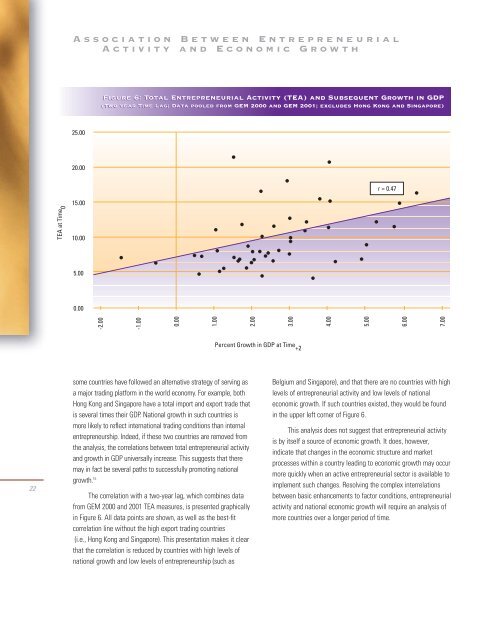Global entrepreneurship report - ResearchGate
Global entrepreneurship report - ResearchGate
Global entrepreneurship report - ResearchGate
Create successful ePaper yourself
Turn your PDF publications into a flip-book with our unique Google optimized e-Paper software.
Association Between Entrepreneurial<br />
Activity and Economic Growth<br />
Figure 6: Total Entrepreneurial Activity (TEA) and Subsequent Growth in GDP<br />
(Two year Time Lag; Data pooled from GEM 2000 and GEM 2001; excludes Hong Kong and Singapore)<br />
25.00<br />
20.00<br />
TEA at Time 0<br />
15.00<br />
10.00<br />
5.00<br />
0.00<br />
-2.00<br />
-1.00<br />
0.00<br />
1.00<br />
2.00<br />
3.00<br />
4.00<br />
5.00<br />
6.00<br />
Percent Growth in GDP at Time +2<br />
r = 0.47<br />
7.00<br />
22<br />
some countries have followed an alternative strategy of serving as<br />
a major trading platform in the world economy. For example, both<br />
Hong Kong and Singapore have a total import and export trade that<br />
is several times their GDP. National growth in such countries is<br />
more likely to reflect international trading conditions than internal<br />
<strong>entrepreneurship</strong>. Indeed, if these two countries are removed from<br />
the analysis, the correlations between total entrepreneurial activity<br />
and growth in GDP universally increase. This suggests that there<br />
may in fact be several paths to successfully promoting national<br />
growth. 15<br />
The correlation with a two-year lag, which combines data<br />
from GEM 2000 and 2001 TEA measures, is presented graphically<br />
in Figure 6. All data points are shown, as well as the best-fit<br />
correlation line without the high export trading countries<br />
(i.e., Hong Kong and Singapore). This presentation makes it clear<br />
that the correlation is reduced by countries with high levels of<br />
national growth and low levels of <strong>entrepreneurship</strong> (such as<br />
Belgium and Singapore), and that there are no countries with high<br />
levels of entrepreneurial activity and low levels of national<br />
economic growth. If such countries existed, they would be found<br />
in the upper left corner of Figure 6.<br />
This analysis does not suggest that entrepreneurial activity<br />
is by itself a source of economic growth. It does, however,<br />
indicate that changes in the economic structure and market<br />
processes within a country leading to economic growth may occur<br />
more quickly when an active entrepreneurial sector is available to<br />
implement such changes. Resolving the complex interrelations<br />
between basic enhancements to factor conditions, entrepreneurial<br />
activity and national economic growth will require an analysis of<br />
more countries over a longer period of time.
















